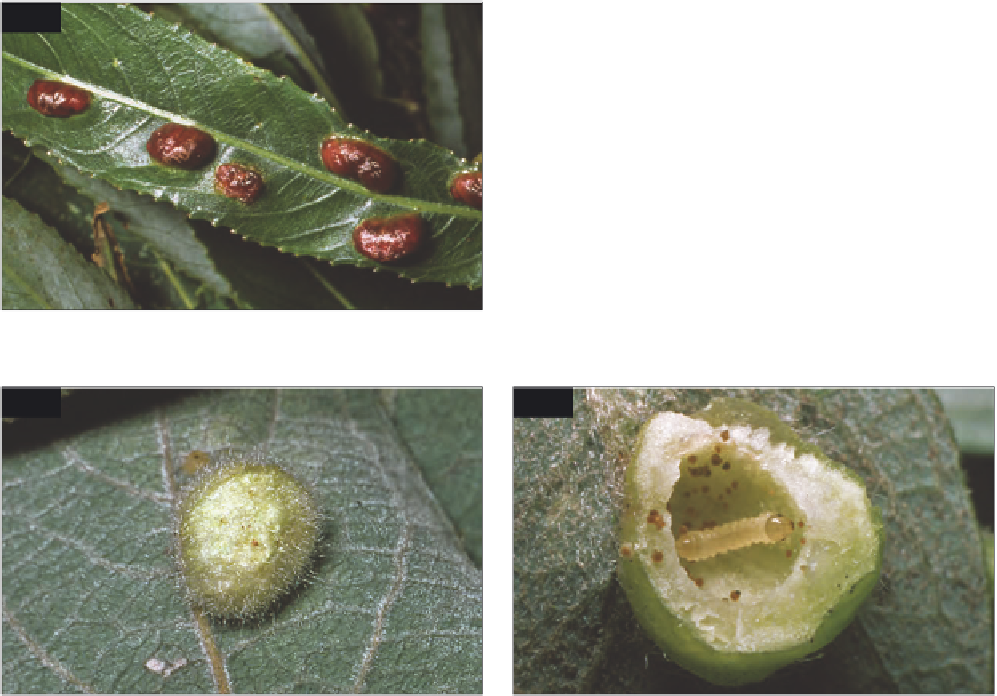Biology Reference
In-Depth Information
Pontania proxima
(Lepeletier) (
1021
)
syn.
P. flavipes
(Cameron);
P. gallicola
(Cameron)
Willow bean-gall sawfly
An often abundant pest of crack willow (
Salix fragilis
)
and white willow (
S. alba
). Widespread throughout
central and northern Europe.
the gall. Fully fed larvae pupate in cocoons spun in the
ground or in bark crevices. Second-generation adults
emerge in July. These deposit eggs in the expanded
leaves, giving rise to gall-inhabiting larvae which
usually complete their development in October.
DAMAGE
Galls spoil the appearance of infested plants but,
although often numerous, have little or no effect on tree
growth.
DESCRIPTION
Adult:
3.0-45 mm long; black and shiny, with whitish-
yellow legs.
Larva:
up to 10 mm long; head brownish
black and shiny; body yellowish green, the legs whitish,
with brown claws.
Pontania bridgmanii
(Cameron)
Sallow bean-gall sawfly
A widely distributed and generally common sawfly, the
larvae developing in relatively flat, dark green, bean-
shaped galls on the leaves of broad-leaved willows
such as common sallow (
Salix atrocinerea
), grey willow
(
S. cinerea
) and pussy willow (
S. caprea
). The galls are
similar in appearance to those of
Pontania proxima
but
usually expanded more above the leaf than below; also,
their surface is smooth and somewhat pubescent,
particularly below; galls on grey sallow are noticeably
larger and less hairy than those on other hosts. The
lifecycle is similar to that of
P. proxima
.
LIFE HISTORY
Adults first appear in May, eggs being deposited in the
leaf buds. As attacked leaves unfurl, galls develop on
the leaf blades, each housing a single larva. The mature
galls, which project equally from both sides of the leaf,
are red above and yellowish green below, with the
surface roughened by numerous small protuberances
and ridges. During its development, the larva expels
frass through a small hole formed in the lower wall of
1021
Pontania pedunculi
(Hartig) (
1022-1023
)
syn.
P. baccarum
(Cameron);
P. bellus
(Zaddach)
Sallow pea-gall sawfly
This common and widely distributed species forms light
greenish, densely hairy, pea-shaped galls, attached to
the midrib on the underside of leaves of broad-leaved
willows, including common sallow (
Salix atrocinerea
),
grey willow (
S. cinerea
) and pussy willow (
S. caprea
)
(cf.
Pontania viminalis
). Each gall measures about 7
mm across and encloses a single larva. Tenanted galls
occur during two main generations, from late May or
early June onwards. Fully grown larvae (10-12 mm
long) are whitish, each with a brown head. They pupate
1021
Galls of willow bean-gall sawfly (
Pontania proxima
).
1022
1023
1022
Gall of sallow pea-gall sawfly (
Pontania pedunculi
).
1023
Larva of sallow pea-gall sawfly (
Pontania pedunculi
).

Search WWH ::

Custom Search